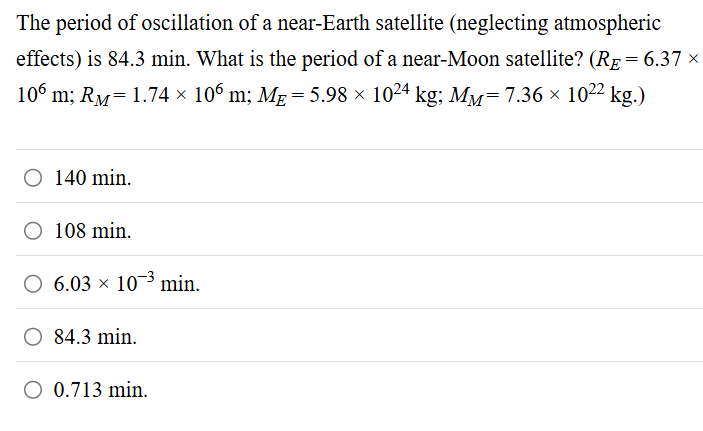The period of oscillation of a near-Earth satellite (neglecting atmospheric effects) is 84.3 min. What is the period of a near-Moon satellite? (R_E = 6.37 × 10^6 m; R_M = 1.74 × 10... The period of oscillation of a near-Earth satellite (neglecting atmospheric effects) is 84.3 min. What is the period of a near-Moon satellite? (R_E = 6.37 × 10^6 m; R_M = 1.74 × 10^6 m; M_E = 5.98 × 10^24 kg; M_M = 7.36 × 10^22 kg.)

Understand the Problem
The question is asking for the calculation of the period of oscillation for a near-Moon satellite based on given parameters and comparing it to a near-Earth satellite's period.
Answer
$T_M \approx 108 \text{ min}$
Answer for screen readers
The period of a near-Moon satellite is approximately $108 \text{ min}$.
Steps to Solve
- Understand the relationship of periods of satellites The period of a satellite in orbit depends on the radius of the orbit and the mass of the celestial body it orbits. The formula for the period $T$ of a satellite is given by:
$$ T = 2\pi \sqrt{\frac{R^3}{GM}} $$
where $R$ is the distance from the center of the celestial body to the satellite, $G$ is the gravitational constant ($6.674 \times 10^{-11} , \text{m}^3 \text{kg}^{-1} \text{s}^{-2}$), and $M$ is the mass of the celestial body.
- Calculate the period for the near-Earth satellite Using the given period of the near-Earth satellite, we can relate the periods for satellites around Earth and the Moon. Since we have:
$$ T_E = 2\pi \sqrt{\frac{R_E^3}{GM_E}} = 84.3 \text{ min} $$
- Calculate the period for the near-Moon satellite For the near-Moon satellite, we will use the same period formula but with parameters for the Moon:
$$ T_M = 2\pi \sqrt{\frac{R_M^3}{GM_M}} $$
To find the relationship, we can divide the two equations:
$$ \frac{T_M^2}{T_E^2} = \frac{R_M^3/M_M}{R_E^3/M_E} $$
Now, substitute the known values:
- $R_M = 6.37 \times 10^6 , \text{m} + 1.74 \times 10^6 , \text{m} = 8.11 \times 10^6 , \text{m}$
- $R_E = 6.37 \times 10^6 , \text{m}$
- $M_M = 7.36 \times 10^{22} , \text{kg}$
- $M_E = 5.98 \times 10^{24} , \text{kg}$
- Substituting the values into the equation Now we have:
$$ \frac{T_M^2}{(84.3 \times 60)^2} = \frac{(8.11 \times 10^6)^3 / (7.36 \times 10^{22})}{(6.37 \times 10^6)^3 / (5.98 \times 10^{24})} $$
This can be solved to find $T_M$.
- Solve for (T_M) and convert back to minutes First, compute each part of the right side, then multiply by $(84.3 \times 60)^2$ and take the square root to find $T_M$.
The period of a near-Moon satellite is approximately $108 \text{ min}$.
More Information
The periods of oscillation for satellites are derived from Kepler's laws of planetary motion. The derived results show that closer bodies (like the Moon) influence the gravitational pull differently, affecting satellite periods.
Tips
- Forgetting to convert the period from minutes to seconds (and vice versa).
- Miscalculating the cube of the radius or the mass of the celestial bodies.
- Neglecting to account for the total distance for the Moon using its radius plus the altitude of the satellite.
AI-generated content may contain errors. Please verify critical information